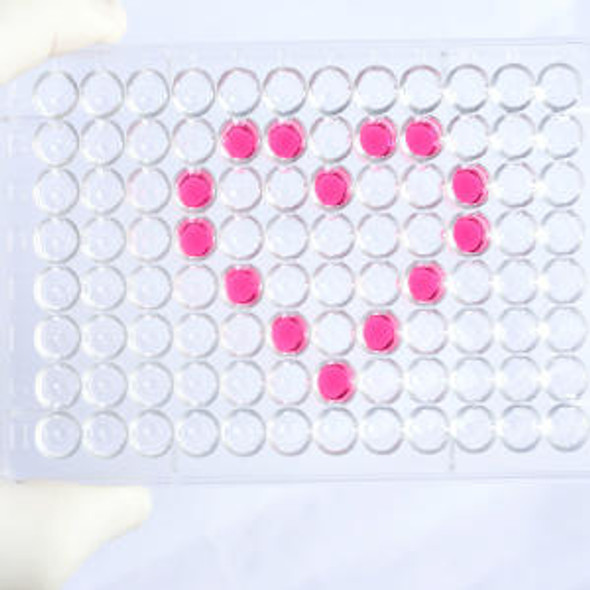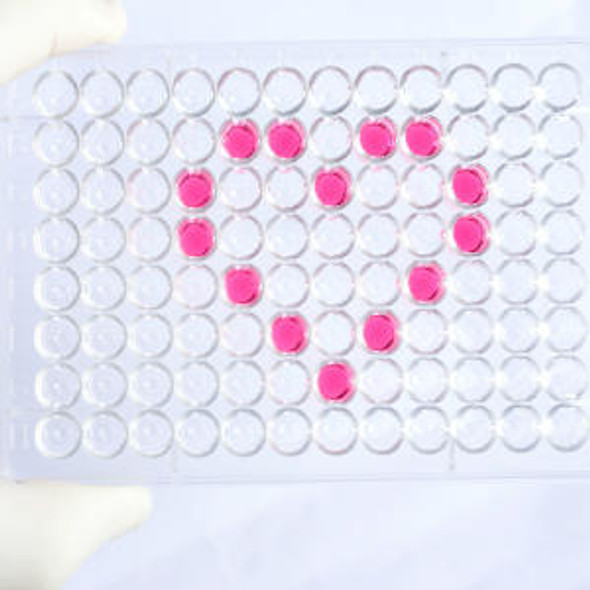Human ZP3 / Zona pellucida sperm-binding protein 3 ELISA Kit
- SKU:
- HUFI01095
- Product Type:
- ELISA Kit
- Size:
- 96 Assays
- Uniprot:
- P21754
- Sensitivity:
- 0.375ng/ml
- Range:
- 0.625-40ng/ml
- ELISA Type:
- Sandwich ELISA, Double Antibody
- Synonyms:
- ZP3, Zona pellucida sperm-binding protein 3, ZP3A, ZP3B, ZPC, Zp-3, Zona pellucida protein C, Zona pellucida glycoprotein 3, Sperm receptor, ZP3A, ZP3B,
- Reactivity:
- Human
Description
Human ZP3 / Zona pellucida sperm-binding protein 3 ELISA Kit
The oocyte and early embryo are surrounded by an extracellular matrix called the zona pellucida. It's mostly made up of three or four glycoproteins that play different roles during fertilisation and preimplantation development. ZP3 is a structural component of the zona pellucida and is involved in sperm acrosome reaction primary binding and induction. The nascent protein has a signal peptide sequence at the N-terminus, a conserved ZP domain at the C-terminus, a consensus furin cleavage site at the C-terminus, and a transmembrane domain at the C-terminus. Furin cleavage is thought to result in the release of the mature protein from the plasma membrane, which is then incorporated into the zona pellucida matrix. However, based on mouse studies, the requirement for furin cleavage in this process is still debatable. Oocyte Maturation Defect 3 and Female Infertility Due To Zona Pellucida Defect are two diseases linked to ZP3.
| Product Name: | Human ZP3 / Zona pellucida sperm-binding protein 3 ELISA Kit |
| Product Code: | HUFI01095 |
| Size: | 96 Assays |
| Alias: | ZP3, Zona pellucida sperm-binding protein 3, ZP3A, ZP3B, ZPC, Zp-3, Zona pellucida protein C, Zona pellucida glycoprotein 3, Sperm receptor, ZP3A, ZP3B |
| Detection method: | Sandwich ELISA, Double Antibody |
| Application: | This immunoassay kit allows for the in vitro quantitative determination of Human ZP3 concentrations in serum plasma and other biological fluids. |
| Sensitivity: | 0.375ng/ml |
| Range: | 0.625-40ng/ml |
| Storage: | 4°C for 6 months |
| Note: | For Research Use Only |
| Recovery: | Matrices listed below were spiked with certain level of Human ZP3 and the recovery rates were calculated by comparing the measured value to the expected amount of Human ZP3 in samples. | ||||||||||||||||
| |||||||||||||||||
| Linearity: | The linearity of the kit was assayed by testing samples spiked with appropriate concentration of Human ZP3 and their serial dilutions. The results were demonstrated by the percentage of calculated concentration to the expected. | ||||||||||||||||
| |||||||||||||||||
| CV(%): | Intra-Assay: CV<8% Inter-Assay: CV<10% |
| Component | Quantity | Storage |
| ELISA Microplate (Dismountable) | 8×12 strips | 4°C for 6 months |
| Lyophilized Standard | 2 | 4°C/-20°C |
| Sample/Standard Dilution Buffer | 20ml | 4°C |
| Biotin-labeled Antibody(Concentrated) | 120ul | 4°C (Protect from light) |
| Antibody Dilution Buffer | 10ml | 4°C |
| HRP-Streptavidin Conjugate(SABC) | 120ul | 4°C (Protect from light) |
| SABC Dilution Buffer | 10ml | 4°C |
| TMB Substrate | 10ml | 4°C (Protect from light) |
| Stop Solution | 10ml | 4°C |
| Wash Buffer(25X) | 30ml | 4°C |
| Plate Sealer | 5 | - |
Other materials and equipment required:
- Microplate reader with 450 nm wavelength filter
- Multichannel Pipette, Pipette, microcentrifuge tubes and disposable pipette tips
- Incubator
- Deionized or distilled water
- Absorbent paper
- Buffer resevoir
| Uniprot | P21754 |
| UniProt Protein Function: | ZP3: The mammalian zona pellucida, which mediates species- specific sperm binding, induction of the acrosome reaction and prevents post-fertilization polyspermy, is composed of three to four glycoproteins, ZP1, ZP2, ZP3, and ZP4. ZP3 is essential for sperm binding and zona matrix formation. Belongs to the ZP domain family. ZPC subfamily. 3 isoforms of the human protein are produced by alternative splicing. |
| UniProt Protein Details: | Protein type:Membrane protein, integral; Extracellular matrix Chromosomal Location of Human Ortholog: 7q11.23 Cellular Component: acrosome; cytoplasm; endoplasmic reticulum; extracellular matrix; extracellular region; extracellular space; Golgi apparatus; multivesicular body; perinuclear region of cytoplasm; plasma membrane; secretory granule Molecular Function:acrosin binding; carbohydrate binding; manganese ion transmembrane transporter activity; protein binding; signal transducer activity; store-operated calcium channel activity Biological Process: binding of sperm to zona pellucida; blastocyst formation; humoral immune response mediated by circulating immunoglobulin; intracellular protein transport; manganese ion transport; negative regulation of transcription, DNA-dependent; oocyte development; phosphoinositide-mediated signaling; positive regulation of humoral immune response; positive regulation of inflammatory response; positive regulation of interferon-gamma production; positive regulation of interleukin-4 production; positive regulation of leukocyte migration; positive regulation of phosphatidylinositol biosynthetic process; positive regulation of protein kinase activity; positive regulation of protein kinase B signaling cascade; positive regulation of T cell proliferation; positive regulation of transcription, DNA-dependent; positive regulation of type IV hypersensitivity |
| NCBI Summary: | The zona pellucida is an extracellular matrix that surrounds the oocyte and early embryo. It is composed primarily of three or four glycoproteins with various functions during fertilization and preimplantation development. The protein encoded by this gene is a structural component of the zona pellucida and functions in primary binding and induction of the sperm acrosome reaction. The nascent protein contains a N-terminal signal peptide sequence, a conserved ZP domain, a C-terminal consensus furin cleavage site, and a transmembrane domain. It is hypothesized that furin cleavage results in release of the mature protein from the plasma membrane for subsequent incorporation into the zona pellucida matrix. However, the requirement for furin cleavage in this process remains controversial based on mouse studies. A variation in the last exon of this gene has previously served as the basis for an additional ZP3 locus; however, sequence and literature review reveals that there is only one full-length ZP3 locus in the human genome. Another locus encoding a bipartite transcript designated POMZP3 contains a duplication of the last four exons of ZP3, including the above described variation, and maps closely to this gene. [provided by RefSeq, Jul 2008] |
| UniProt Code: | P21754 |
| NCBI GenInfo Identifier: | 251757420 |
| NCBI Gene ID: | 7784 |
| NCBI Accession: | P21754.2 |
| UniProt Secondary Accession: | P21754,Q06633, Q29RW0, |
| UniProt Related Accession: | P21754 |
| Molecular Weight: | 41,272 Da |
| NCBI Full Name: | Zona pellucida sperm-binding protein 3 |
| NCBI Synonym Full Names: | zona pellucida glycoprotein 3 (sperm receptor) |
| NCBI Official Symbol: | ZP3 |
| NCBI Official Synonym Symbols: | ZPC; ZP3A; ZP3B; Zp-3 |
| NCBI Protein Information: | zona pellucida sperm-binding protein 3 |
| UniProt Protein Name: | Zona pellucida sperm-binding protein 3 |
| UniProt Synonym Protein Names: | Sperm receptor; ZP3A/ZP3B; Zona pellucida glycoprotein 3; Zp-3 |
| Protein Family: | Zona pellucida sperm-binding protein |
| UniProt Gene Name: | ZP3 |
| UniProt Entry Name: | ZP3_HUMAN |
*Note: Protocols are specific to each batch/lot. For the correct instructions please follow the protocol included in your kit.
Before adding to wells, equilibrate the SABC working solution and TMB substrate for at least 30 min at 37°C. When diluting samples and reagents, they must be mixed completely and evenly. It is recommended to plot a standard curve for each test.
| Step | Protocol |
| 1. | Set standard, test sample and control (zero) wells on the pre-coated plate respectively, and then, record their positions. It is recommended to measure each standard and sample in duplicate. Wash plate 2 times before adding standard, sample and control (zero) wells! |
| 2. | Aliquot 0.1ml standard solutions into the standard wells. |
| 3. | Add 0.1 ml of Sample / Standard dilution buffer into the control (zero) well. |
| 4. | Add 0.1 ml of properly diluted sample ( Human serum, plasma, tissue homogenates and other biological fluids.) into test sample wells. |
| 5. | Seal the plate with a cover and incubate at 37 °C for 90 min. |
| 6. | Remove the cover and discard the plate content, clap the plate on the absorbent filter papers or other absorbent material. Do NOT let the wells completely dry at any time. Wash plate X2. |
| 7. | Add 0.1 ml of Biotin- detection antibody working solution into the above wells (standard, test sample & zero wells). Add the solution at the bottom of each well without touching the side wall. |
| 8. | Seal the plate with a cover and incubate at 37°C for 60 min. |
| 9. | Remove the cover, and wash plate 3 times with Wash buffer. Let wash buffer rest in wells for 1 min between each wash. |
| 10. | Add 0.1 ml of SABC working solution into each well, cover the plate and incubate at 37°C for 30 min. |
| 11. | Remove the cover and wash plate 5 times with Wash buffer, and each time let the wash buffer stay in the wells for 1-2 min. |
| 12. | Add 90 µl of TMB substrate into each well, cover the plate and incubate at 37°C in dark within 10-20 min. (Note: This incubation time is for reference use only, the optimal time should be determined by end user.) And the shades of blue can be seen in the first 3-4 wells (with most concentrated standard solutions), the other wells show no obvious color. |
| 13. | Add 50 µl of Stop solution into each well and mix thoroughly. The color changes into yellow immediately. |
| 14. | Read the O.D. absorbance at 450 nm in a microplate reader immediately after adding the stop solution. |
When carrying out an ELISA assay it is important to prepare your samples in order to achieve the best possible results. Below we have a list of procedures for the preparation of samples for different sample types.
| Sample Type | Protocol |
| Serum | If using serum separator tubes, allow samples to clot for 30 minutes at room temperature. Centrifuge for 10 minutes at 1,000x g. Collect the serum fraction and assay promptly or aliquot and store the samples at -80°C. Avoid multiple freeze-thaw cycles. If serum separator tubes are not being used, allow samples to clot overnight at 2-8°C. Centrifuge for 10 minutes at 1,000x g. Remove serum and assay promptly or aliquot and store the samples at -80°C. Avoid multiple freeze-thaw cycles. |
| Plasma | Collect plasma using EDTA or heparin as an anticoagulant. Centrifuge samples at 4°C for 15 mins at 1000 × g within 30 mins of collection. Collect the plasma fraction and assay promptly or aliquot and store the samples at -80°C. Avoid multiple freeze-thaw cycles. Note: Over haemolysed samples are not suitable for use with this kit. |
| Urine & Cerebrospinal Fluid | Collect the urine (mid-stream) in a sterile container, centrifuge for 20 mins at 2000-3000 rpm. Remove supernatant and assay immediately. If any precipitation is detected, repeat the centrifugation step. A similar protocol can be used for cerebrospinal fluid. |
| Cell culture supernatant | Collect the cell culture media by pipette, followed by centrifugation at 4°C for 20 mins at 1500 rpm. Collect the clear supernatant and assay immediately. |
| Cell lysates | Solubilize cells in lysis buffer and allow to sit on ice for 30 minutes. Centrifuge tubes at 14,000 x g for 5 minutes to remove insoluble material. Aliquot the supernatant into a new tube and discard the remaining whole cell extract. Quantify total protein concentration using a total protein assay. Assay immediately or aliquot and store at ≤ -20 °C. |
| Tissue homogenates | The preparation of tissue homogenates will vary depending upon tissue type. Rinse tissue with 1X PBS to remove excess blood & homogenize in 20ml of 1X PBS (including protease inhibitors) and store overnight at ≤ -20°C. Two freeze-thaw cycles are required to break the cell membranes. To further disrupt the cell membranes you can sonicate the samples. Centrifuge homogenates for 5 mins at 5000xg. Remove the supernatant and assay immediately or aliquot and store at -20°C or -80°C. |
| Tissue lysates | Rinse tissue with PBS, cut into 1-2 mm pieces, and homogenize with a tissue homogenizer in PBS. Add an equal volume of RIPA buffer containing protease inhibitors and lyse tissues at room temperature for 30 minutes with gentle agitation. Centrifuge to remove debris. Quantify total protein concentration using a total protein assay. Assay immediately or aliquot and store at ≤ -20 °C. |
| Breast Milk | Collect milk samples and centrifuge at 10,000 x g for 60 min at 4°C. Aliquot the supernatant and assay. For long term use, store samples at -80°C. Minimize freeze/thaw cycles. |









